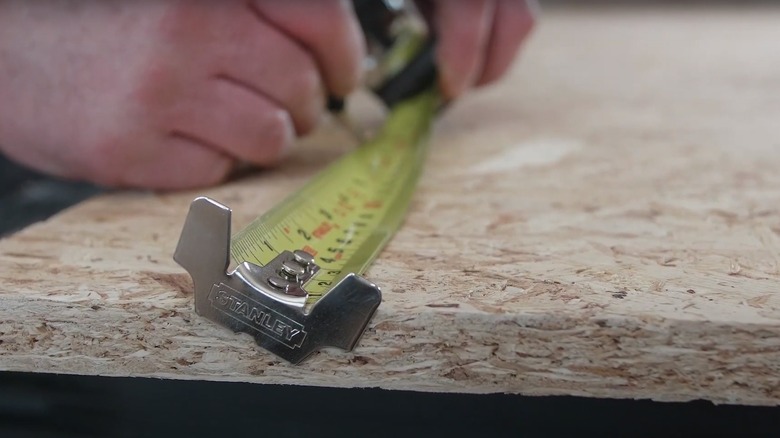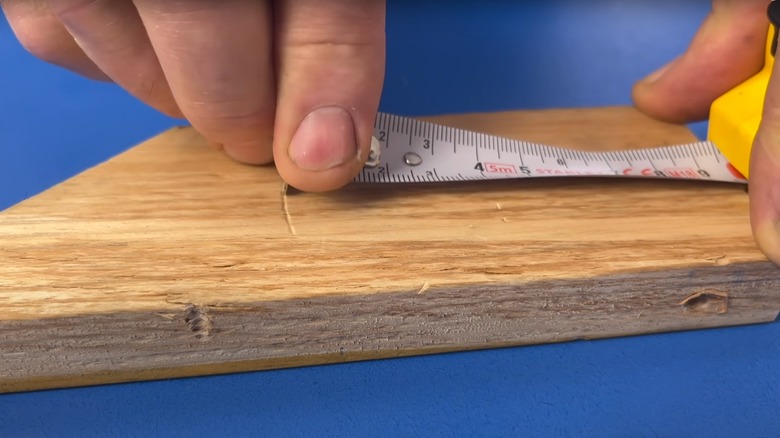Why Your Tape Measure Has Grooves On The Metal Tip
The tape measure is an interesting tool. Using it is extremely easy, but it also has several features that can save you a lot of time. Even if you don't know about all of them and might not even need to use them, the options are available to you. You can use the tape measure as a makeshift notepad or get an accurate measurement of the square footage of your home. However, one hack that can be quite beneficial and time-saving in the right situation is the grooved edge on the metal tab at the end of the tape. The grooves behave like serrations on a steak knife, allowing you to create a slight mark on the item being measured. You then know exactly where to place the nail or screw without needing to mark it with a pencil.
Most metal tape measures are made for construction and have the desired set of grooves at the end of the metal tip. Regardless of whether the case consists of rubber, plastic, or metal (or a combination), as long as the tape is metal, it nearly always will have a grooved tip. If you use a fabric measuring tape, however, it's not likely to have a metal tip with a serrated edge. Most fabric tapes like this work better for making measurements on cloth rather than construction-type measurements.
How to use the serrated edge on the measuring tape
To use this metal tape measure hack, it's helpful to have two people if you need to make several marks over a long distance. When measuring a 2x4 to make a cut, most people will hook the tab at the end of the tape over the edge of the board, marking the measurement with a pencil on the opposite end. To make this hack work, you need to keep the metal tab available to create the groove, so you almost have to work backward from how you would typically use a tape measure. Having a second person holding the back end of the measuring tape helps. If you're only measuring a short distance, you can hold it yourself on both ends. Once it's in place, push down on the serrated tip edge and move it slightly back and forth to scrape the material.
Inspect the metal tip on the end of the tape to see if it will work well for this hack. A tip with more grooves or sharper grooves should make marking the spot on your material easier. Some tape measures have multiple notches on their wider tips, making it easier to create a groove. With a cheaper tape measure, the tip may only have one tiny notch on it. You then may have to apply extra force to create the mark.
Instances where you can make use of the tape measure hack
Before attempting to use this hack, it's essential to consider the type of material you're using. Among the most common materials used in construction, the metal tip will have the best luck creating a mark on drywall or a 2x4 piece of wood, as these are slightly softer than other construction materials. Your marks may show up on masonry, too. However, marking metal or glass this way is unlikely to work.
This hack works well for a process called tab scratching. Lock the measuring tape at the desired distance, such as 12 inches. Make a 12-inch mark with the tab, then move the locked tape measure to the groove mark. Make a mark at the next 12-inch distance, continuing all the way to the end of the material. Tab-scratching likely won't result in precise measurements as you move across the material. It's only useful for quick measurements where accuracy isn't vital.To make a mark for hanging a picture, use the tab to scratch the location for the nail or screw. You then can hide the gouge underneath the image. If you need to make a quick cut on a length of drywall, use the tab to create a scratch line across the drywall to roughly mark the line for a quick cut. Again, this is only useful for speed, not accuracy, as the line probably won't be very straight.


